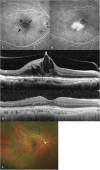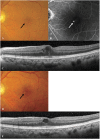CLINICAL FEATURES OF TREATED AND UNTREATED TYPE 1 IDIOPATHIC MACULAR TELANGIECTASIA WITHOUT THE OCCURRENCE OF SECONDARY CHOROIDAL NEOVASCULARIZATION FOLLOWED FOR 2 YEARS IN JAPANESE PATIENTS
- PMID: 28541960
- PMCID: PMC5753814
- DOI: 10.1097/IAE.0000000000001724
CLINICAL FEATURES OF TREATED AND UNTREATED TYPE 1 IDIOPATHIC MACULAR TELANGIECTASIA WITHOUT THE OCCURRENCE OF SECONDARY CHOROIDAL NEOVASCULARIZATION FOLLOWED FOR 2 YEARS IN JAPANESE PATIENTS
Abstract
Purpose: To evaluate the clinical features of Type 1 idiopathic macular telangiectasia (IMT) followed up for 2 years.
Methods: Forty-nine patients with unilateral Type 1 IMT were examined. Thirty-one IMT eyes were treated with direct laser photocoagulation and/or intravitreal bevacizumab; the remaining 18 eyes, with good vision or slight macular edema, were untreated. Changes in best-corrected visual acuity and central retinal thickness between baseline and 24 months after the initial visit were examined.
Results: Of 49 eyes, nine were treated with direct laser photocoagulation, 12 with laser photocoagulation and intravitreal bevacizumab, 10 with intravitreal bevacizumab monotherapy, whereas 18 did not receive any treatment. The mean logarithm of the minimum angle of resolution best-corrected visual acuity was 0.20 ± 0.19 (median, 20/29) and 0.13 ± 0.22 (median, 20/25) at baseline and 24 months, respectively (P = 0.023). The mean central retinal thickness was 375.0 ± 94.5 μm and 315.3 ± 78.5 μm at baseline and 24 months, respectively (P < 0.001). Retinal vein occlusion and retinal macroaneurysm occurred in six eyes and one eye, respectively, during follow-up.
Conclusion: Treatment with laser photocoagulation and/or intravitreal bevacizumab may be effective for Type 1 IMT, 36.7% of IMT eyes required no treatment over a 2-year follow-up, and other retinal vascular events were not uncommon.
Conflict of interest statement
C. Shiragami received financial support from Bayer (Osaka, Japan) and Novartis (Tokyo, Japan). A. Tsujikawa received financial support from Pfizer (Tokyo, Japan), Bayer (Osaka, Japan), Novartis (Tokyo, Japan), Santen (Osaka, Japan), Senju (Osaka, Japan), Alcon (Tokyo, Japan), Nidek (Gamagori, Japan), AMO Japan (Tokyo, Japan), Hoya (Tokyo, Japan), Kowa (Nagoya, Japan), Sanwa Kagaku (Nagoya, Japan), and the Ministry of Health Labour and Welfare of Japan, and Japan Society for the Promotion of Science (Tokyo, Japan). None of the remaining authors has any conflicting interests to disclose.
Figures





Comment in
-
Correspondence.Retina. 2020 Sep;40(9):e53-e54. doi: 10.1097/IAE.0000000000002912. Retina. 2020. PMID: 32842093 No abstract available.
-
Reply.Retina. 2020 Sep;40(9):e54. doi: 10.1097/IAE.0000000000002911. Retina. 2020. PMID: 32842094 No abstract available.
Similar articles
-
Bevacizumab versus bevacizumab and macular grid photocoagulation for macular edema in eyes with non-ischemic branch retinal vein occlusion: results from a prospective randomized study.Graefes Arch Clin Exp Ophthalmol. 2019 May;257(5):913-920. doi: 10.1007/s00417-018-04223-9. Epub 2019 Jan 4. Graefes Arch Clin Exp Ophthalmol. 2019. PMID: 30610424 Clinical Trial.
-
EFFICACY AND FREQUENCY OF INTRAVITREAL AFLIBERCEPT VERSUS BEVACIZUMAB FOR MACULAR EDEMA SECONDARY TO CENTRAL RETINAL VEIN OCCLUSION.Retina. 2018 Sep;38(9):1795-1800. doi: 10.1097/IAE.0000000000001782. Retina. 2018. PMID: 28767552 Clinical Trial.
-
Combination therapy with intravitreal bevacizumab and macular grid and scatter laser photocoagulation in patients with macular edema secondary to branch retinal vein occlusion.J Ocul Pharmacol Ther. 2015 Apr;31(3):179-85. doi: 10.1089/jop.2014.0069. Epub 2015 Feb 25. J Ocul Pharmacol Ther. 2015. PMID: 25715024
-
CHANGES IN CENTRAL CHOROIDAL THICKNESS AFTER TREATMENT OF DIABETIC MACULAR EDEMA WITH INTRAVITREAL BEVACIZUMAB CORRELATION WITH CENTRAL MACULAR THICKNESS AND BEST-CORRECTED VISUAL ACUITY.Retina. 2018 May;38(5):970-975. doi: 10.1097/IAE.0000000000001645. Retina. 2018. PMID: 28426622
-
MICROSTRUCTURAL EFFECTS OF INTRAVITREAL BEVACIZUMAB IN IDIOPATHIC CHOROIDAL NEOVASCULARISATION.J Ayub Med Coll Abbottabad. 2015 Apr-Jun;27(2):259-63. J Ayub Med Coll Abbottabad. 2015. PMID: 26411092
Cited by
-
Bilateral Type 1 Idiopathic Macular Telangiectasia in a Female Patient: Multimodal Imaging of a Rare Presentation.Case Rep Ophthalmol. 2021 May 10;12(2):373-379. doi: 10.1159/000513095. eCollection 2021 May-Aug. Case Rep Ophthalmol. 2021. PMID: 34054487 Free PMC article.
-
Direct navigated laser photocoagulation as primary treatment for retinal arterial macroaneurysms.Int J Retina Vitreous. 2018 Aug 22;4:28. doi: 10.1186/s40942-018-0133-z. eCollection 2018. Int J Retina Vitreous. 2018. PMID: 30151240 Free PMC article.
-
Multimodal Imaging Findings and Treatment with Dexamethasone Implant in Three Cases of Idiopathic Macular Telangiectasia Type 1.Case Rep Ophthalmol. 2021 Apr 6;12(1):92-97. doi: 10.1159/000509850. eCollection 2021 Jan-Apr. Case Rep Ophthalmol. 2021. PMID: 33976663 Free PMC article.
References
-
- Gass JD, Blodi BA. Idiopathic juxtafoveolar retinal telangiectasis. Update of classification and follow-up study. Ophthalmology 1993;100:1536–1546. - PubMed
-
- Yannuzzi LA, Bardal AM, Freund KB, et al. Idiopathic macular telangiectasia. Arch Ophthalmol 2006;124:450–460. - PubMed
-
- Maruko I, Iida T, Sugano Y, et al. Demographic features of idiopathic macular telangiectasia in Japanese patients. Jpn J Ophthalmol 2012;56:152–158. - PubMed
-
- Takayama K, Ooto S, Tamura H, et al. Intravitreal bevacizumab for type 1 idiopathic macular telangiectasia. Eye (Lond) 2010;24:1492–1497. - PubMed
MeSH terms
Substances
LinkOut - more resources
Full Text Sources
Other Literature Sources

